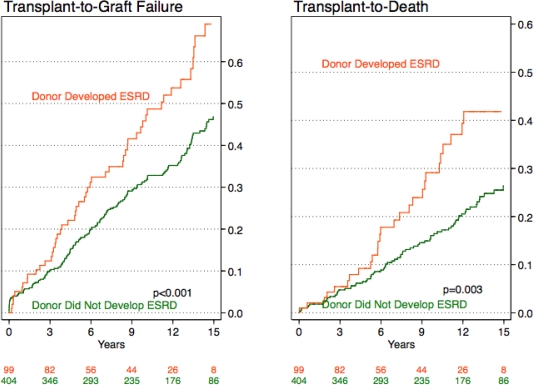Live Donor Kidney Transplantation: Recipient Outcomes When the Donor Developed ESRD
Johns Hopkins University, Baltimore, MD.
Meeting: 2015 American Transplant Congress
Abstract number: B169
Keywords: Graft failure
Session Information
Session Name: Poster Session B: Living Donor Issues 1
Session Type: Poster Session
Date: Sunday, May 3, 2015
Session Time: 5:30pm-6:30pm
 Presentation Time: 5:30pm-6:30pm
Presentation Time: 5:30pm-6:30pm
Location: Exhibit Hall E
Recipient outcomes when the donor developed ESRD remain uncharacterized.
Method: A cohort of 99 LDKT recipients between 04/1994-11/2011, whose donors subsequently developed ESRD, was compared with a matched cohort of 404 LDKT recipients, whose donors did not develop ESRD. Matching was based on donor age, race, relationship-to-recipient, HLA mismatch, PRA, recipient age, race, BMI, cause of ESRD, sex, time-on-dialysis, and year of transplant. Maximum follow-up was 15-years; median follow-up was 7.6-years (interquartile range [IQR], 3.9-11.5 years).
Results: Recipient outcomes (69% graft failure and 42% mortality at 15 years) were worse among recipients whose donor developed ESRD compared with recipients whose donor did not develop ESRD (47% graft failure and 26% mortality at 15 years; adjusted HR=1.7, p<0.001 for graft failure; adjusted HR=1.9, p=0.003 for mortality)(Table 1 & Figure 1). This effect varied substantially by donor race/ethnicity, predonation BMI, and eGFR (Figure 2).
| Subgroups | 15-year Recipient Graft Failure (%) | Adjusted HR (95%CI) | P |
| Donor Developed ESRD | 69 | 1.74 | <.001 |
| Donor Did Not Develop ESRD | 47 | Ref | |
| Donor White, Developed ESRD | 76 | 2.42 | <.001 |
| Donor White, Did Not Develop ESRD | 41 | Ref | |
| Donor Black, Developed ESRD | 55 | 1.12 | .7 |
| Donor Black, Did Not Develop ESRD | 57 | Ref | |
| Donor Hispanic, Developed ESRD | 69 | 1.35 | .5 |
| Donor Hispanic, Developed ESRD | 45 | Ref | |
| Donor BMI<30, Developed ESRD | 48 | 1.02 | .9 |
| Donor BMI<30, Did Not Develop ESRD | 47 | Ref | |
| Donor BMI>=30, Developed ESRD | 71 | 2.03 | <.001 |
| Donor BMI>=30, Did Not Develop ESRD | 45 | Ref | |
| Donor eGFR<90, Developed ESRD | 75 | 1.61 | .3 |
| Donor eGFR<90, Did Not Develop ESRD | 34 | Ref | |
| Donor eGFR>=90, Developed ESRD | 68 | 1.8 | <.001 |
| Donor eGFR>=90, Did Not Develop ESRD | 47 | Ref |


Conclusions: Recipient outcomes were worse for recipients whose donor developed ESRD, but only when the donor was white, obese, with high predonation eGFR.
To cite this abstract in AMA style:
Muzaale A, Massie A, Segev D. Live Donor Kidney Transplantation: Recipient Outcomes When the Donor Developed ESRD [abstract]. Am J Transplant. 2015; 15 (suppl 3). https://atcmeetingabstracts.com/abstract/live-donor-kidney-transplantation-recipient-outcomes-when-the-donor-developed-esrd/. Accessed January 5, 2026.« Back to 2015 American Transplant Congress
